Two explosive products dominate the world, generating nearly one billion yuan in annual revenue: Chinese food, a model for the development of district and county economy and industry
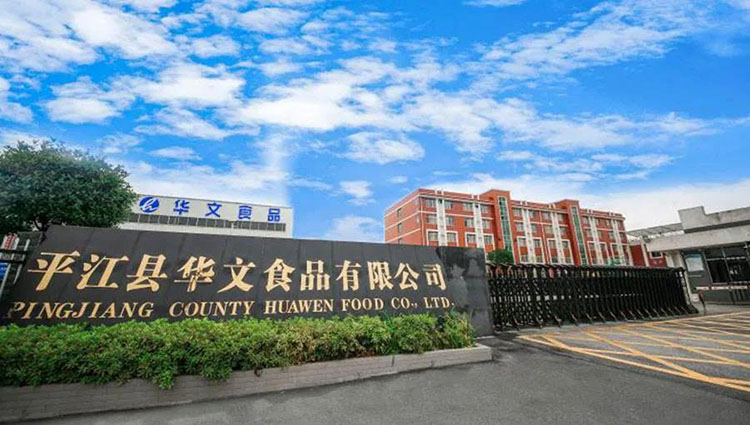
Author | Shang Limu
Process Editor | Little White
There are almost no accounts receivable on the books, and upstream and downstream distributors provide the company with nearly 100 million yuan in interest free loans every year
The freshly caught small fish is washed clean, removed of internal organs, heated in an iron pot with firewood, baked over low heat, and then naturally cooled. It is then smoked with rice husks, peanut shells, orange peels, sawdust, and other ingredients to create a fresh, savory, and chewy Pingjiang snack. This is Pingjiang roasted fish.
Just looking at the baking program makes my mouth water. Pingjiang Fire Roasted Fish ranks first among Pingjiang cuisine and is also one of Grandpa Mao's favorite dishes.
1、 "Jinzai" flavored small fish and flavored dried tofu stand out in the world
In 2010, Zhou Jinsong, a native of Pingjiang who had been starting a business in a foreign land for many years and had been working in the leisure food industry for nearly 20 years, returned to his hometown to start a business and founded Huawen Food (003000. SZ), with the aim of leading Pingjiang Fire Roasted Fish, a local delicacy, to the world.
According to the prospectus, Zhou Jinsong and his wife currently hold a total of 44.62% equity and are the actual controllers of Huawen Food.
After years of research and development, on the basis of Pingjiang roasted fish, Huawen Food has launched the "Jinzai" flavored small fish. The flavor dried tofu produced by boss Zhou since 1990 was also named after "Jinzai". dried tofu was also developed based on the famous Pingjiang food "Pingjiang soy sauce dried bean".
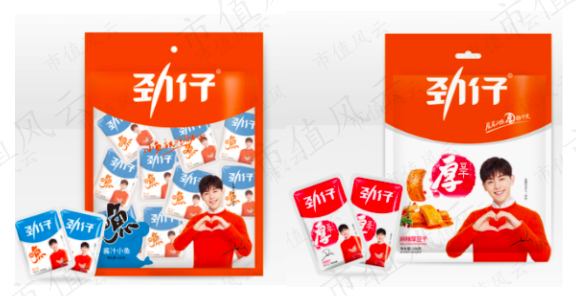
In fact, "Jinzai" flavor small fish and flavor dried tofu also carry the burden of Chinese food.
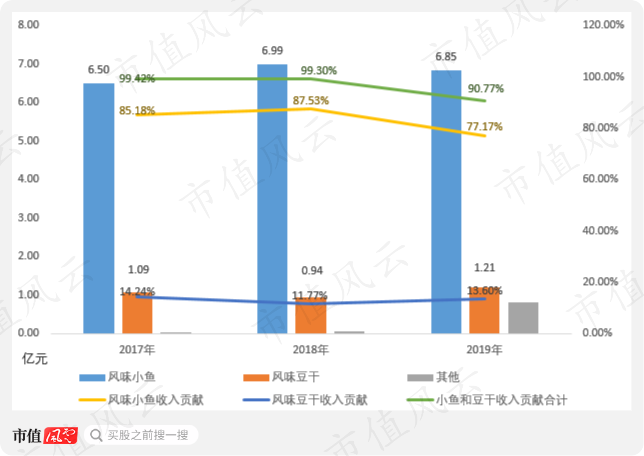
From the perspective of revenue growth, in 2017, the production capacity of Huawen Food's flavored small fish increased from 6000 tons to 15000 tons, resulting in a surge of 93.16% in revenue and a 192.58% increase in net profit attributable to the parent company, directly leading the company to a new level.
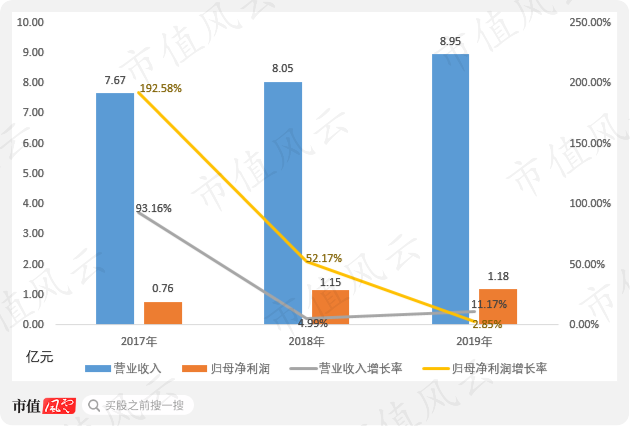
In 2018 and 2019, the revenue of Huawen Food continued to grow steadily. It is worth mentioning that the new flavor jerky and konjac products launched in 2018 have shown significant growth momentum. Especially for flavored dried meat, the operating revenue in 2019 was 66.59 million yuan, 128 times that of 2018.

There is a view in the investment industry that when a product's revenue exceeds 100 million, it will quickly usher in a round of high-speed revenue growth. The flavor jerky business of Chinese food is worth looking forward to.
2、 The advantages of brand companies are obvious in market competition
Let's take a look at the industry situation.
The localization of leisure food in our country started in the early 21st century, but in the early days, it was still mainly based on small vendor style stalls. The real start of corporate operation was around 2010, which is also around the time when Chinese food was established.
Take Zhouhei duck, who is also familiar to all, for example. Its founder started to engage in stewed food in 1995, but it didn't have its first store until 2002. It didn't start corporate operation until 2006, and began to expand its scale with the help of capital around 2009.
According to Frost&Sullivan's calculations, the scale of China's snack food industry exceeded one trillion yuan in 2018, with a compound annual growth rate of nearly 12% from 2013 to 2018.
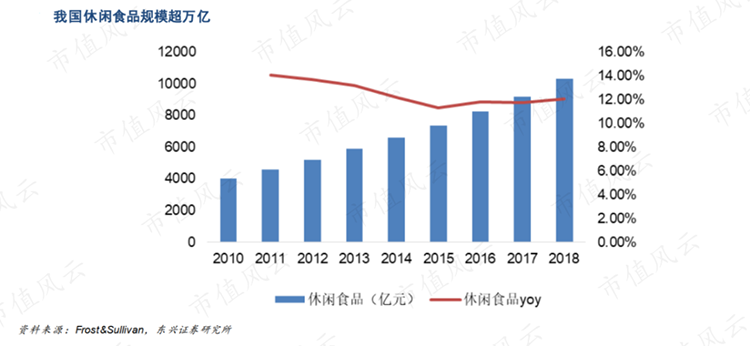
Although growing rapidly, China's snack food industry is still in a period of industrial dividends. In terms of per capita consumption, the per capita consumption of leisure food in China is about 60% of that in Japan and South Korea, and only about 20% of that in Europe and America.
According to a research report by Chuancai Securities, big brands are seizing the opportunity to grab market share: since 2010, the growth rate of the non brand leisure brine product market has only been 5% -10%, while the growth rate of the brand leisure brine product market is as high as 29% -33%.
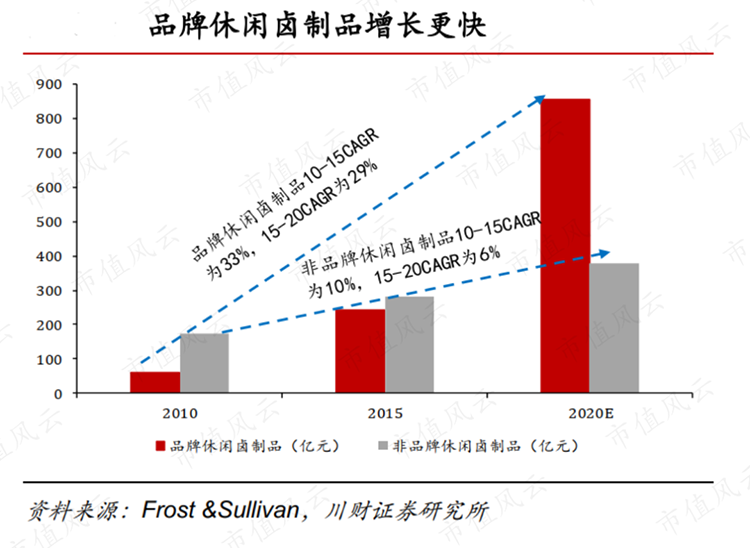
Mr. Zhou, who has been in the industry for many years, clearly understands this. Since its establishment, Huawen Food has focused on brand building and has invested nearly 100 million yuan in brand promotion over the past three years. From the perspective of income growth, the investment effect is very good, but Fengyunjun thinks that the dealer data is obviously more convincing, so keep reading.
3、 Whether the brand is strong or not, dealers have the most say
The distribution model is the main way for Chinese food to sell products.
From 2017 to 2019, the products sold by Huawen Food through the distribution model accounted for 97.39%, 96.45%, and 95.76% of the sales revenue, respectively. The products were mainly sold domestically, but also exported to nearly 30 countries across the country such as the United States, Canada, and Australia.
According to different channels, Huawen Food divides distributors into distribution channel distributors, supermarket channel distributors, and e-commerce channel distributors, corresponding to different downstream customers.

1. First come, first served, flat distribution structure
Chinese food usually considers counties/regions as a typical distribution area. The hierarchical structure of its distributors is a flat first level distributor management model, and there is no need to build a multi-level distribution structure to complete product sales. Therefore, distributors have the characteristics of small scale and large quantity.
From 2017 to 2019, the number of distributors cooperating with Huawen Food was 1328, 1335, and 1515 respectively, forming a distribution network covering the whole country.
Huawen Food sets sales targets for the following year at the end of each year, and decomposes them into various sales regions, signing sales tasks with various distributors.
Cooperate with distributors through a buyout distribution model of payment before delivery;
Unable to enjoy sales rebates if sales tasks are not completed;
If a distributor's remaining products are not eligible for return as stipulated in the distributor's framework contract due to revocation, the distributor shall bear the relevant risks on their own.
The benefits of payment before delivery are self-evident, as it can ensure the company's cash flow.
In recent years, Huawen Food has almost no accounts receivable. The reason why it is almost so is because it has given certain payment terms to some direct customers, but the magnitude can be ignored.

But objectively speaking, the conditions for this distribution model are still a bit harsh.
2. Gold and silver cups are not as good as dealer reputation
Over the past three years, more than 80% of Huawen Food's revenue has been contributed by distributors who were retained at the beginning of the period and were not revoked that year, accounting for 83.51%, 82.94%, and 86.52% respectively, which is stable and slightly increasing.
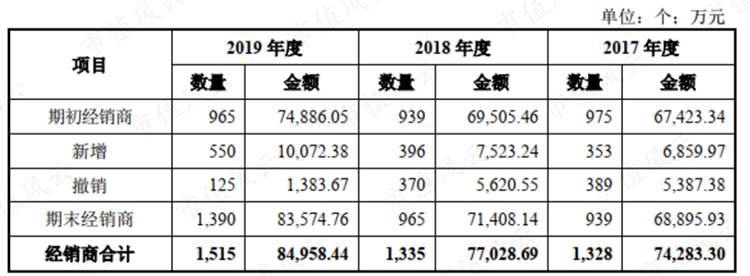
If the conditions are strict and there are still stable dealers to cooperate with and retain, it means that the dealers have made money. Otherwise, who would have time to join you in the fun.
From the perspective of cooperation time, in 2019, nearly 70% of the company's revenue was contributed by distributors who had cooperated for more than four years, which to some extent reflects the company's position and reputation among distributors.
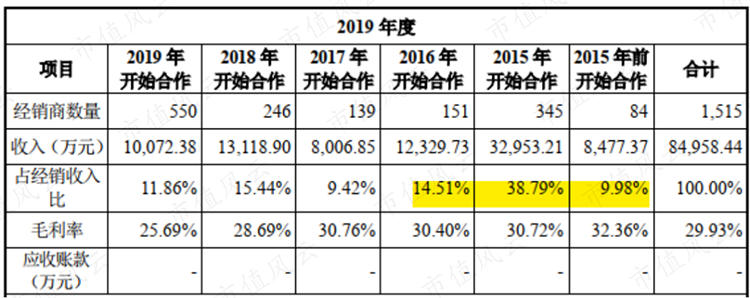
4、 Adequate supply of raw materials ensures stable taste
After discussing sales, let's take a look at supply.
Maotai sells expensive because of limited production capacity, and there are only so many of the best glutinous red sorghum and wine cellars available. Fast moving consumer goods and Maotai have different routes, but they are equally concerned about limited raw materials. Is there a guarantee for the supply of raw materials for Chinese food?
The main raw materials of "Jinzai" flavor small fish and flavor dried tofu are anchovy and soybeans. Everyone is familiar with soybeans. Talk about anchovy alone.
The anchovy is a common small marine fish that is widely distributed in major sea areas around the world. Although there are a large number of anchovies in China's coastal areas, due to environmental protection and urban planning, it is not possible to provide drying facilities for them.
The anchovy used in the production of Chinese food mainly comes from the waters of Vietnam, Thailand and other countries, with sufficient supply. There have been slight fluctuations in the past three years, but overall it is relatively stable.
The stability of raw materials means the stability of taste. In recent years, there have been news reports that Lao Gan Ma's taste has deteriorated significantly due to the use of Henan chili peppers.
5、 Excellent cash flow and inventory turnover performance
In recent years, it can be said that there has been a peak period for the listing of leisure food products, including Yanjin Shop, Liangpin Shop, Youyou Food, and many other peers. So, what is the competitive advantage of Chinese food?
1. Profitability in the industry
The gross profit margin of Chinese food is basically the same as that of Yanjinpuzi and Liangpinpuzi, with Yanjinpuzi slightly higher.
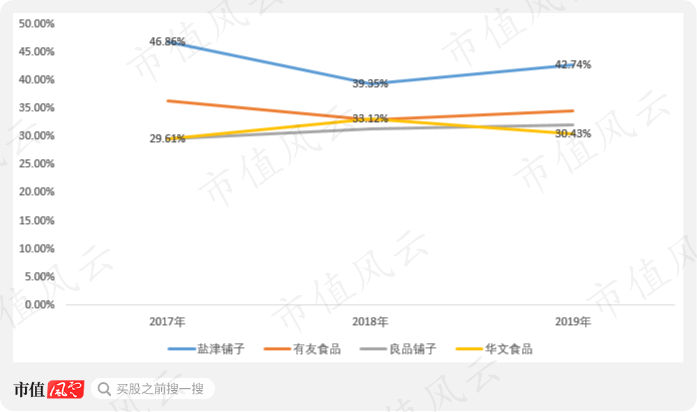
The main reason for the high gross profit margin of Yanjinpuzi is that it mainly sells through supermarket channels and needs to pay various fees such as entry fees and barcode fees to supermarkets. The operating expenses are relatively high, and Yanjinpuzi has considered the above-mentioned expenses that need to be borne in the pricing process of sales prices.
The net profit margin avoids the impact caused by different sales channels and sales models. From the perspective of net profit margin, Huawen Food is higher than Yanjinpuzi, and in some years it is even much higher.

Overall, the profitability of Huawen Food is basically consistent with comparable listed companies, ranking in the upper middle, reflecting the overall profit range of the leisure food industry.
2. Strong premium ability in the industrial chain
In the past three years, Huawen Food has not had any interest bearing liabilities on its books, so naturally there is no interest expense.
To put it bluntly, there is no debt pressure.
With the success of this listing, the raised funds have further increased the company's cushion, giving the company greater room for development and maneuvering.

And the absence of debt is related to the company's strong premium ability in the industry chain. As mentioned earlier, the principle of 'payment before delivery' and 'no return if not sold' is not applicable, but in fact, it goes far beyond that.
Huawen Food not only has almost no accounts receivable, but also can occupy more than 30 million yuan of payable goods from upstream suppliers every year, and can receive advance purchase payments from downstream distributors. As shown in the following figure:
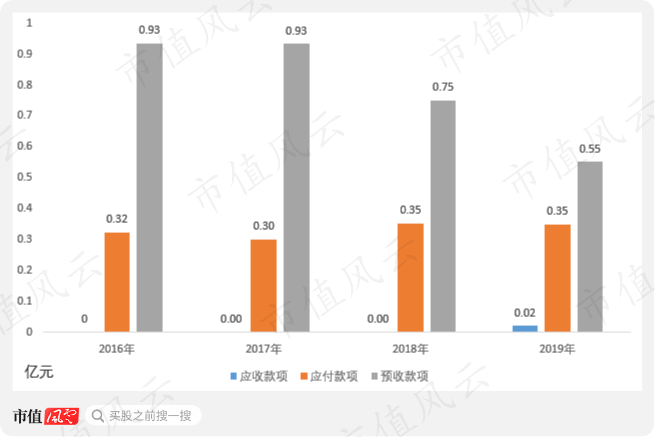
In some years, we received nearly 100 million yuan in advance payments. Although there has been a decrease in the past two years, there was still 55.18 million yuan in 2019. To put it more vividly, upstream suppliers and downstream distributors provide the company with approximately 100 million yuan in interest free loans annually.
You should know that from a business model perspective, this is almost perfect.
3. There is no risk of inventory backlog
Fengyun Jun will take you to understand the inventory turnover situation of Huawen Shares again.

In recent years, the turnover frequency of Chinese food inventory has remained relatively stable. With a slight increase in income growth, but overall it is relatively stable.
85% of the inventory consists of raw materials. Within a quarter, Huawen Food can process them into finished products and sell them, with almost no risk of inventory backlog.
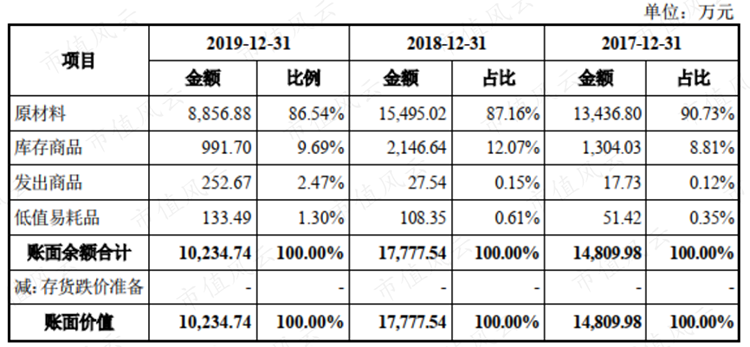
In the inventory, finished products only account for about 10%, which means that the produced finished products are quickly sold out, and there is no risk of inventory backlog.
4. The epidemic has not hindered the growth momentum
In 2020, the sudden outbreak of the epidemic covered everyone, but at the same time, the epidemic was also a mirror reflecting the ability of enterprises to cope with risks.
In the first half of 2020, Huawen Food's operating revenue increased by 2.55%, net profit increased by 5.05%, and non GAAP net profit increased by 5.78%.
The performance may not be particularly impressive, but it is rare to have achieved such results during the pandemic. Especially considering the company's proximity to Hubei, the impact on production resumption may be greater.

brief summary
Overall, Huawen Food is a company with strong fundamentals and bargaining power in the upstream and downstream of the industry chain. Huawen Food has grown from a county leisure food company to an excellent listed company in the industry. The company has inherited local cuisine and developed the industrial economy of counties, especially providing new reference directions for the industrial economy of inland counties.
They are far away from the coast, without vast foreign trade markets, convenient transportation, and limited financial support, but they also need development, employment, and ensuring the prosperity and housing of the local people. We need to make the wanderers in the distance 'see the mountains, see the water, and remember their homesickness'.
With the promotion of the registration system, more traditional food enterprises with local characteristics can learn from the development experience of Chinese food, enter the capital market, and ensure the prosperity of the local people.


